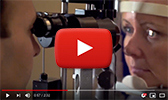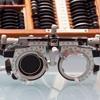Cataracts occur when the lens in the eye thickens and becomes cloudy and yellow. This can prevent light entering the eye from reaching the retina and may cause distortion or loss of vision. Cataracts occur as a natural part of the aging process in most cases and are the leading cause of treatable blindness in people over 60. To treat cataracts, the cloudy lens must be surgically removed and replaced with an Intraocular Lens (IOL) implant, which helps to restore vision. Today, implants such as the AcrySof® Toric lens and the ReSTOR® Multifocal lens, offer varying levels of vision restoration up to and including freedom from glasses or contacts (in appropriate patients). The doctors of Fifth Avenue Associates have trained extensively in the art of cataract extraction, an art that they teach to future generations of ophthalmologists. In addition, our physicians have been invited internationally to teach advanced cataract surgery techniques to ophthalmologists abroad.
What are cataracts?
The lens of the eye, located behind the iris and the pupil, helps to focus light on the retina, which in turn sends nerve signals and images to the brain. A clear, normally functioning lens focuses sharp, crisp images on the retina, which contributes to clear vision. When a cataract develops, the lens yellows or becomes cloudy and less light focuses on the retina, causing blurred images to be transmitted to the brain. The change in clarity of the lens is defined as a "cataract" once it starts to become visually symptomatic. Patients tend to complain of decreased distance and /or reading vision, decreased night vision, loss of image clarity, dulling of colors and increasing glare around lights. Cataracts can occur in either one eye or both eyes simultaneously.
What are the causes of cataracts?
Over 90% of cataracts are related to the normal aging process. The remaining cataract cases are caused by certain congenital and acquired conditions of the eye as well as certain medications that can lead to cataracts at any age.
What is cataract surgery?
The only treatment for cataracts is a short, outpatient surgical procedure to remove the cloudy lens and the implantation of a permanent Intraocular Lens (IOL) to restore the focusing power on the retina. Dr.'s Elahi, Chen and Schwartz are highly skilled in the most advanced techniques available for cataract surgery. This often includes topical anesthesia without the use of needles, stitchless incisions and the use of ultrasonic waves to break up the cataract (phacoemulsification). Once the cataract is removed, an IOL that is precisely measured for your eye is implanted. The majority of cataract surgeries are performed at an ambulatory surgery center; however, some patients may prefer or have medical conditions that necessitate surgery at The Mount Sinai Medical Center.
What are my cataract surgery options?
There are many choices today when deciding upon the right Intraocular Lens (IOL) for you. IOLs offer a range of vision restoration from a continuing need for glasses or contacts to complete vision correction similar to that seen in refractive surgeries such as LASIK or PRK. As a result, your doctor may ask, "What level of vision correction would you like to receive?" or "How much do you dislike wearing glasses?" Your answers to these questions will lead the discussion and evaluation down different pathways.
"I don't mind wearing glasses or readers."
If this is your response to the questions above, then your doctor will suggest standard or monofocal IOLs, which are often fully covered by insurance. Monofocal IOLs can be targeted for either distance or near vision depending on your preference. When monofocal IOLs are implanted, you will be able to clearly see objects in the distance but will need reading glasses to focus on close objects such as the newspaper.
"I have astigmatism and would like to be able to see distant objects clearly"
Astigmatism occurs when the cornea is shaped more like a cylinder (like the shape of a football) than a sphere (like the shape of a basketball). This shape leads to multiple images being cast on the retina and subsequent blurring of an image. While treatments such as LASIK, PRK, Limbal relaxing incisions or astigmatic keratotomies are available for the treatment of astigmatism, prior to now there has been no lens implant that could be inserted after cataract surgery that would correct a person's astigmatism. Standard lens implants do not correct for astigmatism and a person might continue to experience blurred or distorted vision after cataract surgery without the use of glasses or contact lenses.
For those patients with astigmatism who would like freedom from eyeglasses for distance vision after cataract surgery, there is now a better option. The Acrysof® Toric lens is a foldable lens that your surgeon implants after cataract surgery to replace the clouded lens. The unique design of the Toric lens makes it possible to significantly reduce or eliminate astigmatism and improves uncorrected distance vision.
Our surgeons were among the first in Manhattan to be approved to implant these unique lenses and continue to see excellent results. Ask your doctor if a Toric lens may be right for you.
Limbal Relaxing Incisions
In some cases of astigmatism, precise incisions can be made using a diamond knife along the outside edge (limbus) of the cornea. These incisions, at an exact depth and location, can reduce or eliminate astigmatism at the time of cataract surgery or independent of cataract surgery. These incisions may be necessary in certain cases of multifocal lens implantation, as multifocal lenses work best when astigmatism has been eliminated. Generally, lower amounts of astigmatism can be corrected using this technique and larger amounts may require laser vision correction.
"I'd like to be able to see clearly without glasses or contacts"
At birth, the lens of the eye is not only clear but also elastic, and as a result, the lens can change shape and power for near tasks such as reading. As we age this elasticity is lost, leading to a condition called presbyopia, which usually begins in the fifth decade. Typically after a cataract is removed, a lens implant is placed in the eye which can correct distance vision, but glasses are still needed for near tasks including reading, computer work, make-up application, and various hobbies.
We now have the advanced technology of the Restor® multifocal lens, which has the ability to correct not only distance but also near vision. In the clinical study, 80% of patients who had a Restor® multifocal lens implanted reported that they never wore glasses for distance activities such as driving or near activities such as reading. Dr.'s Elahi, Chen and Schwartz are among a handful of surgeons in Manhattan certified to implant the Restor® multifocal intraocular lens after cataract surgery. Ask your doctor if the Restor® multifocal lens may be right for you.
Another option for those seeking independence from glasses or contact lenses after cataract surgery is monovision. In this situation, standard monofocal IOLs are used with the lens implanted in the dominant eye correcting for distance vision and the lens implanted in the non-dominant eye correcting for near vision. The brain adapts to the new visual situation, and after surgery, many patients are free from glasses for the majority of activities. Monovision is not right for all patients but is an excellent option for some. Ask your doctor if monovision may be right for you.
Cataract Surgery: Introduction
Cataracts: Is It Time For Surgery?
Cataract Surgery: Traditional Vs Laser
Considerations for Your IOL Choice
Cataract Surgery: Benefits
Cataract Surgery: Conclusion


Fifth Avenue Associates
1034 Fifth Avenue
New York, NY 10028
Phone: 212-570-0707
Fax: 212-570-0555
Email: [email protected]

Dry Eye Syndrome
Cataracts
Droopy Eyes
Bags Under The Eyes
Ptosis
Ectropion/Entropion
Eyelid Cancers
Refractive Surgery
Thyroid Eye Disease
Tear Duct Conditions
Pediatric Eye Care
Blepharospasm

For contact details and patient forms please click below.

Your gift can help Virtue Foundation tackle critical issues and make a positive impact around the globe.

Click here to view and listen to the latest Fifth Avenue Associates audio/Video Clips